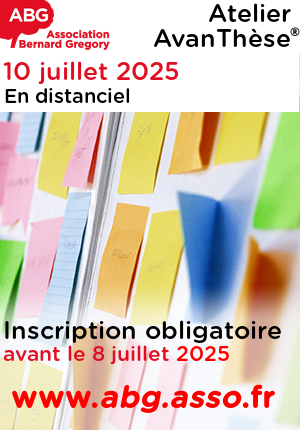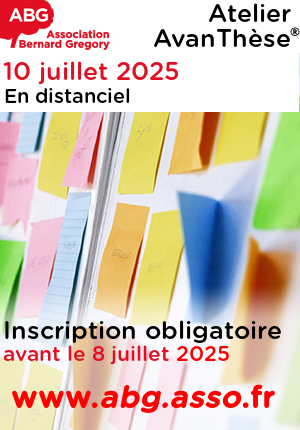COOPÉRATION METAL-LIGAND AVEC DES COMPLEXES PINCES NHC-YLURE DE PHOSPHONIUM // METAL-LIGAND COOPERATION WITH NHC-PHOSPHONIUM YLIDE PINCER COMPLEXES
|
ABG-126728
ADUM-59607 |
Thesis topic | |
| 2024-11-07 |
Université Toulouse III - Paul Sabatier
Toulouse Cedex 4 - France
COOPÉRATION METAL-LIGAND AVEC DES COMPLEXES PINCES NHC-YLURE DE PHOSPHONIUM // METAL-LIGAND COOPERATION WITH NHC-PHOSPHONIUM YLIDE PINCER COMPLEXES
- Chemistry
Synthèse organique, Chimie des carbènes, Chimie du phosphore, Chimie de coordination, Catalyse homogène
Organic synthesis, Carbene chemistry, Phosphorus chemistry, Coordination Chemistry, Homogeneous catalysis
Organic synthesis, Carbene chemistry, Phosphorus chemistry, Coordination Chemistry, Homogeneous catalysis
Topic description
Parmi la grande variété de ligands disponibles, les ligands carbonés sont devenus incontournables, notamment avec l'émergence des carbènes N-hétérocycliques (NHC). Les ylures de phosphonium (PY : R3P+-CR2− <-> R3P=CR2), qui représentent une classe alternative de ligands carbonés neutres, peuvent également agir comme bases de Lewis efficaces en chimie de coordination. Considérant les caractéristiques intrinsèques des ligands NHC et ylures de phosphonium, similaires en termes de propriétés électroniques, mais différents en termes de mode de liaison, le développement de versions polydentates combinant les deux extrémités carbonées est apparu comme un défi naturel.(1) Des complexes NHC-ylure de phosphonium Pd(II) riches en électrons basés sur un pont propyle en C3 ont ainsi été récemment préparés dans la série bidentate (A),(2) et dans la série pince,(3) le système pince (B) étant actif dans l'allylation catalytique des aldéhydes. En parallèle, un complexe Mn(I) bidenté à base de NHC (C) comportant un ylure de phosphonium (PYr) lié de manière inversée au centre métallique a été rapporté comme activant le dihydrogène via un nouveau mode de coopération métal-ligand agissant comme l'un des précatalyseurs les plus efficaces pour l'hydrogénation des cétones.(4)
Sur la base de ces résultats, nous proposons de préparer des complexes pinces inédits de type D présentant un ligand NHC-bis(ylure) N-substitué par deux donneurs d'ylure de phosphonium, l'un des ylures étant lié au métal de manière conventionnelle pour lui conférer une forte densité électronique et l'autre de manière non conventionnelle pour lui apporter son caractère non innocent. Les caractéristiques électroniques et stériques apportées par ce ligand pince NHC-bis(ylure) devraient bénéficier à la stabilisation des centres métalliques dans des états d'oxydation élevés ainsi qu'à des applications en catalyse homogène. La préparation de complexes D pourrait constituer une avancée dans la conception de nouveaux systèmes coopératifs à base de carbone, tant d'un point de vue fondamental que dans la perspective d'applications (fichier pdf joint).
------------------------------------------------------------------------------------------------------------------------------------------------------------------------
------------------------------------------------------------------------------------------------------------------------------------------------------------------------
Among the large variety of ligands made available, carbon ligands have become essential, especially with the emergence of N-heterocyclic carbenes (NHC). Phosphonium ylides (PY: R3P+-CR2− <-> R3P=CR2), which represent an alternative class of neutral carbon ligands can also act as effective Lewis bases in coordination chemistry. Considering the intrinsic features of NHC and phosphonium ylide ligands, similar in terms of electronic properties, but different in terms of bonding mode, the development of polydentate versions combining both carbon extremities appeared as a natural challenge.(1) Electron-rich NHC-phosphonium ylide Pd(II) complexes based on a C3 propyl bridge were thus recently prepared in the bidentate (A),(2) and in the pincer series,(3) the pincer system (B) being active in the catalytic allylation of aldehydes. In parallel, a bidentate NHC-based Mn(I) complex (C) featuring a phosphonium ylide (PYr) bound in a reversed fashion to the metal center was reported to activate dihydrogen through a new mode of metal-ligand cooperation acting as one of the most efficient pre-catalyst for ketone hydrogenation.(4)
Based on these results, we propose to prepare unprecedented pincer complexes of type D exhibiting NHC core ligand N-substituted by two phosphonium ylide donors, one ylide being bound to the metal in a conventional manner to provide strong electron density and the other one in an unconventional manner to bring its non-innocent character. The electronic and steric features provided by this NHC-bis(ylide) pincer ligand should benefit for the stabilization of metal centers in high oxidation states as well as for applications in homogeneous catalysis. The preparation of complexes D could constitute a step forward in the design of new cooperative carbon-based systems, both from a fundamental point of view but also in the perspective of applications (attached pdf file).
------------------------------------------------------------------------------------------------------------------------------------------------------------------------
------------------------------------------------------------------------------------------------------------------------------------------------------------------------
Début de la thèse : 01/10/2025
WEB : https://www.lcc-toulouse.fr/ingenierie-moleculaire-des-pre-catalyseurs-equipe-a/
Sur la base de ces résultats, nous proposons de préparer des complexes pinces inédits de type D présentant un ligand NHC-bis(ylure) N-substitué par deux donneurs d'ylure de phosphonium, l'un des ylures étant lié au métal de manière conventionnelle pour lui conférer une forte densité électronique et l'autre de manière non conventionnelle pour lui apporter son caractère non innocent. Les caractéristiques électroniques et stériques apportées par ce ligand pince NHC-bis(ylure) devraient bénéficier à la stabilisation des centres métalliques dans des états d'oxydation élevés ainsi qu'à des applications en catalyse homogène. La préparation de complexes D pourrait constituer une avancée dans la conception de nouveaux systèmes coopératifs à base de carbone, tant d'un point de vue fondamental que dans la perspective d'applications (fichier pdf joint).
------------------------------------------------------------------------------------------------------------------------------------------------------------------------
------------------------------------------------------------------------------------------------------------------------------------------------------------------------
Among the large variety of ligands made available, carbon ligands have become essential, especially with the emergence of N-heterocyclic carbenes (NHC). Phosphonium ylides (PY: R3P+-CR2− <-> R3P=CR2), which represent an alternative class of neutral carbon ligands can also act as effective Lewis bases in coordination chemistry. Considering the intrinsic features of NHC and phosphonium ylide ligands, similar in terms of electronic properties, but different in terms of bonding mode, the development of polydentate versions combining both carbon extremities appeared as a natural challenge.(1) Electron-rich NHC-phosphonium ylide Pd(II) complexes based on a C3 propyl bridge were thus recently prepared in the bidentate (A),(2) and in the pincer series,(3) the pincer system (B) being active in the catalytic allylation of aldehydes. In parallel, a bidentate NHC-based Mn(I) complex (C) featuring a phosphonium ylide (PYr) bound in a reversed fashion to the metal center was reported to activate dihydrogen through a new mode of metal-ligand cooperation acting as one of the most efficient pre-catalyst for ketone hydrogenation.(4)
Based on these results, we propose to prepare unprecedented pincer complexes of type D exhibiting NHC core ligand N-substituted by two phosphonium ylide donors, one ylide being bound to the metal in a conventional manner to provide strong electron density and the other one in an unconventional manner to bring its non-innocent character. The electronic and steric features provided by this NHC-bis(ylide) pincer ligand should benefit for the stabilization of metal centers in high oxidation states as well as for applications in homogeneous catalysis. The preparation of complexes D could constitute a step forward in the design of new cooperative carbon-based systems, both from a fundamental point of view but also in the perspective of applications (attached pdf file).
------------------------------------------------------------------------------------------------------------------------------------------------------------------------
------------------------------------------------------------------------------------------------------------------------------------------------------------------------
Début de la thèse : 01/10/2025
WEB : https://www.lcc-toulouse.fr/ingenierie-moleculaire-des-pre-catalyseurs-equipe-a/
Funding category
Funding further details
Financement CSC - china scholarship council
Presentation of host institution and host laboratory
Université Toulouse III - Paul Sabatier
Institution awarding doctoral degree
Université Toulouse III - Paul Sabatier
Graduate school
482 SDM - SCIENCES DE LA MATIERE - Toulouse
Candidate's profile
Le candidat devra avoir si possible une expérience en chimie organométallique de synthèse, en synthèse organique, en catalyse homogène et en diverses méthodes spectroscopiques. Il ou elle doit être très motivé, enthousiaste, autonome et apprécier le travail enéquipe. Les candidatures doivent inclure une lettre de motivation et un CV détaillé avec le nom et l'adresse de deux références.
The applicant will have a strong background in synthetic organometallic chemistry, organic synthesis, homogeneous catalysis andvarious spectroscopic methods. He or she should be highly motivated, enthusiastic, autonomous, and should appreciate working in ateam. Applications should include a cover letter and a detailed CV with the name and address of two references.
The applicant will have a strong background in synthetic organometallic chemistry, organic synthesis, homogeneous catalysis andvarious spectroscopic methods. He or she should be highly motivated, enthusiastic, autonomous, and should appreciate working in ateam. Applications should include a cover letter and a detailed CV with the name and address of two references.
2025-07-31
Apply
Close
Vous avez déjà un compte ?
Nouvel utilisateur ?
More information about ABG?
Get ABG’s monthly newsletters including news, job offers, grants & fellowships and a selection of relevant events…
Discover our members
 ONERA - The French Aerospace Lab
ONERA - The French Aerospace Lab  Généthon
Généthon  ADEME
ADEME  Nokia Bell Labs France
Nokia Bell Labs France  ANRT
ANRT  Ifremer
Ifremer  MabDesign
MabDesign  Groupe AFNOR - Association française de normalisation
Groupe AFNOR - Association française de normalisation  PhDOOC
PhDOOC  CASDEN
CASDEN  CESI
CESI  MabDesign
MabDesign  TotalEnergies
TotalEnergies  Aérocentre, Pôle d'excellence régional
Aérocentre, Pôle d'excellence régional  Institut Sup'biotech de Paris
Institut Sup'biotech de Paris  Tecknowmetrix
Tecknowmetrix  SUEZ
SUEZ  ASNR - Autorité de sûreté nucléaire et de radioprotection - Siège
ASNR - Autorité de sûreté nucléaire et de radioprotection - Siège  Laboratoire National de Métrologie et d'Essais - LNE
Laboratoire National de Métrologie et d'Essais - LNE





